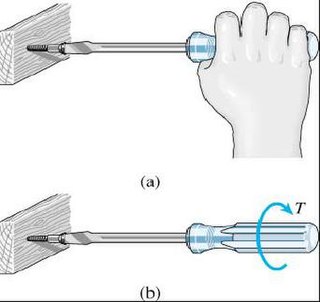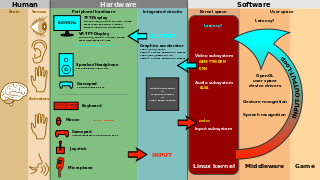Software testing is the act of examining the artifacts and the behavior of the software under test by validation and verification. Software testing can also provide an objective, independent view of the software to allow the business to appreciate and understand the risks of software implementation. Test techniques include, but not necessarily limited to:
The Common Criteria for Information Technology Security Evaluation is an international standard for computer security certification. It is currently in version 3.1 revision 5.

A prototype is an early sample, model, or release of a product built to test a concept or process. It is a term used in a variety of contexts, including semantics, design, electronics, and software programming. A prototype is generally used to evaluate a new design to enhance precision by system analysts and users. Prototyping serves to provide specifications for a real, working system rather than a theoretical one. In some design workflow models, creating a prototype is the step between the formalization and the evaluation of an idea.

Usability can be described as the capacity of a system to provide a condition for its users to perform the tasks safely, effectively, and efficiently while enjoying the experience. In software engineering, usability is the degree to which a software can be used by specified consumers to achieve quantified objectives with effectiveness, efficiency, and satisfaction in a quantified context of use.
Test-driven development (TDD) is a software development process relying on software requirements being converted to test cases before software is fully developed, and tracking all software development by repeatedly testing the software against all test cases. This is as opposed to software being developed first and test cases created later.
A technical writer is a professional information communicator whose task is to transfer information between two or more parties, through any medium that best facilitates the transfer and comprehension of the information. Technical writers research and create information through a variety of delivery media. Example types of information include online help, manuals, white papers, design specifications, project plans, and software test plans. With the rise of e-learning, technical writers are increasingly becoming involved with creating online training material.

In systems engineering and software engineering, requirements analysis focuses on the tasks that determine the needs or conditions to meet the new or altered product or project, taking account of the possibly conflicting requirements of the various stakeholders, analyzing, documenting, validating and managing software or system requirements.

In systems engineering, information systems and software engineering, the systems development life cycle (SDLC), also referred to as the application development life-cycle, is a process for planning, creating, testing, and deploying an information system. The systems development life cycle concept applies to a range of hardware and software configurations, as a system can be composed of hardware only, software only, or a combination of both. There are usually six stages in this cycle: requirement analysis, design, development and testing, implementation, documentation, and evaluation.

A website wireframe, also known as a page schematic or screen blueprint, is a visual guide that represents the skeletal framework of a website. The term wireframe is taken from other fields that use a skeletal framework to represent 3 dimensional shape and volume. Wireframes are created for the purpose of arranging elements to best accomplish a particular purpose. The purpose is usually driven by a business objective and a creative idea. The wireframe depicts the page layout or arrangement of the website's content, including interface elements and navigational systems, and how they work together. The wireframe usually lacks typographic style, color, or graphics, since the main focus lies in functionality, behavior, and priority of content. In other words, it focuses on what a screen does, not what it looks like. Wireframes can be pencil drawings or sketches on a whiteboard, or they can be produced by means of a broad array of free or commercial software applications. Wireframes are generally created by business analysts, user experience designers, developers, visual designers, and by those with expertise in interaction design, information architecture and user research.
In computing, a scenario is a narrative of foreseeable interactions of user roles and the technical system, which usually includes computer hardware and software.

User interface (UI) design or user interface engineering is the design of user interfaces for machines and software, such as computers, home appliances, mobile devices, and other electronic devices, with the focus on maximizing usability and the user experience. In computer or software design, user interface (UI) design primarily focuses on information architecture. It is the process of building interfaces that clearly communicates to the user what's important. UI design refers to graphical user interfaces and other forms of interface design. The goal of user interface design is to make the user's interaction as simple and efficient as possible, in terms of accomplishing user goals.
In software development and product management, a user story is an informal, natural language description of features of a software system. They are written from the perspective of an end user or user of a system, and may be recorded on index cards, Post-it notes, or digitally in project management software. Depending on the project, user stories may be written by different stakeholders like client, user, manager, or development team.
A product manager (PM) is a professional role that is responsible for the development of products for an organization, known as the practice of product management. Product managers own the product strategy behind a product, specify its functional requirements, and manage feature releases. Product managers coordinate work done by many other functions, and are ultimately responsible for product outcomes. Product managers traditionally resided in the marketing organizations of technology companies, but have since additionally become staples of engineering and even product-specific teams.
A test engineer is a professional who determines how to create a process that would best test a particular product in manufacturing and related disciplines, in order to assure that the product meets applicable specifications. Test engineers are also responsible for determining the best way a test can be performed in order to achieve adequate test coverage. Often test engineers also serve as a liaison between manufacturing, design engineering, sales engineering and marketing communities as well.

Scrum, or SCRUM, is a framework for project management, with an initial emphasis on software development, although it has been used in other fields including research, sales, marketing and advanced technologies. It is designed for teams of ten or fewer members, who break their work into goals that can be completed within time-boxed iterations, called sprints, no longer than one month and most commonly two weeks. The scrum team assesses progress in time-boxed daily meetings of 15 minutes or fewer, called daily scrums. At the end of the sprint, the team holds two further meetings: the sprint review which demonstrates the work done to stakeholders to elicit feedback, and sprint retrospective which enables the team to reflect and improve.

A functional specification in systems engineering and software development is a document that specifies the functions that a system or component must perform.

In software development, the V-model represents a development process that may be considered an extension of the waterfall model, and is an example of the more general V-model. Instead of moving down in a linear way, the process steps are bent upwards after the coding phase, to form the typical V shape. The V-Model demonstrates the relationships between each phase of the development life cycle and its associated phase of testing. The horizontal and vertical axes represent time or project completeness (left-to-right) and level of abstraction, respectively.
Consumer adoption of technological innovations is the process consumers use to determine whether or not to adopt an innovation. This process is influenced by consumer characteristics, such as personality traits and demographic or socioeconomic factors, the characteristics of the new product, such as its relative advantage and complexity, and social influences, such as opinion leaders.
Business requirements, also known as stakeholder requirements specifications (StRS), describe the characteristics of a proposed system from the viewpoint of the system's end user like a CONOPS. Products, systems, software, and processes are ways of how to deliver, satisfy, or meet business requirements. Consequently, business requirements are often discussed in the context of developing or procuring software or other systems.
Specification by example (SBE) is a collaborative approach to defining requirements and business-oriented functional tests for software products based on capturing and illustrating requirements using realistic examples instead of abstract statements. It is applied in the context of agile software development methods, in particular behavior-driven development. This approach is particularly successful for managing requirements and functional tests on large-scale projects of significant domain and organisational complexity.








